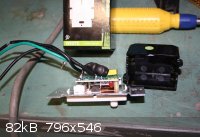| Pages:
1
..
5
6
7 |
watson.fawkes
International Hazard
    
Posts: 2793
Registered: 16-8-2008
Member Is Offline
Mood: No Mood
|
|
Quote: Originally posted by Endo  | | Well, I found 1000Watt Dimmers for $7.50 each online. [...] I dug through some stuff and found an old heat sink from an Athalon Thunderbird processor
and drilled it to mount the triac. |
This is really good practical modification. I blurbed it in another thread on controlling heating mantles. I suggested there using this in conjunction with a dedicated ammeter on the panel.
Could you provide us all the exact brand and model number of the dimmer you used? It would be good to know, if ordering one of these by mail, that it
has a triac of the right packaging to make this easy. The RD91 package the triac is in makes the mod much easier, particularly over remotely mounting
a TO-220 package or worse yet, one of the PCB-only packages. See the spec sheet for the BTA25-600B to see that it's certainly possible to get unlucky on the device packaging.
|
|
|
Endo
Hazard to Others
  
Posts: 124
Registered: 5-1-2006
Location: USA
Member Is Offline
Mood: Cold
|
|
The model of the dimmer is LUXDM1000-02L The manufacturer name on the packaging is SecurElectric Corporation.
http://www.homelectrical.com/single-pole-1000w-slide-dimmer-...
The back cover is held on with two screws and comes off easily. It comes with four holes at the top and four at the bottom, so I didn't have to drill
to get the three new wires out.
To get the Triac out I used a dremel tool with a cutoff wheel to cut the top off of the pop rivet holding the triac to the heatsink (A small copper
plate) and through the aluminum facing. A few minutes with the solder iron got it loose, then just added the wires and pulled them through the
pre-drilled holes in the case. Two were really easy because they matched up with some solder joins for other large wires. The third connection was a
fairly small patch on the board to hook the wire but easily doable.
Oh I wasn't 100% but from the documentation I could find on the Triac I belive the back plate of it must be grounded. I just drilled a second hole
and used a screw to hook a ground wire up to the heatsink.
Hope this helps if someone else wants to try it.

|
|
|
watson.fawkes
International Hazard
    
Posts: 2793
Registered: 16-8-2008
Member Is Offline
Mood: No Mood
|
|
Quote: Originally posted by Endo  | The model of the dimmer is LUXDM1000-02L [...]
Oh I wasn't 100% but from the documentation I could find on the Triac I belive the back plate of it must be grounded. I just drilled a second hole
and used a screw to hook a ground wire up to the heatsink.
Hope this helps if someone else wants to try it. |
Thanks for the model number. The spec sheet for the triac
states the following: | Quote: | | By using an internal ceramic pad, the BTA series provides voltage insulated tab (rated at 2500V RMS) complying with UL standards
|
In other words, the metal mounting tabs on the case are electrically isolated from the triac connections or
the device itself. Hooking up a bonding wire to the heatsink is still the right thing to do. The heat sink is a conductor whose potential would
otherwise float. It's always right bond such a conductor to ground. This bonding wire doesn't ordinary carry current; it's for conducting fault
current to ground so that other protection devices operate.
What has helped me most is knowing there's a 25A triac hiding inside that consumer device. Single unit quantities for that model triac is more than
$5, so why not buy the whole assembly? I've been thinking I'll make a general-purpose dimmer box with it with its own outlet, since it would be able
to handle anything that the 15A circuit on a typical wall outlet would. My guess is that a similar 600W dimmer unit has a 15A triac inside, for that
matter.
|
|
|
Texium
|
Thread Moved
20-11-2023 at 12:06 |
| Pages:
1
..
5
6
7 |